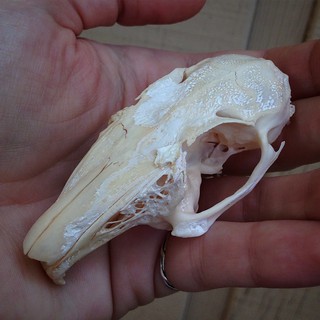
Adipocere is the product of a chemical reaction in which fats react with water and hydrogen in the presence of bacterial enzymes, breaking down into fatty acids and soaps. Adipocere is resistant to bacteria and can protect a corpse, slowing further decomposition. The transformation of fats into adipocere occurs best in an environment that has an absence of oxygen and high levels of moisture. Adipocere formation begins within a month of death, and, in the absence of air, it can persist for centuries.
It is not uncommon for adipocere to be found on bones. Either found in a natural setting or while being processed. I've found that the best time to remove it is either A) when the bones are freshly out of maceration or peroxide and you use a toothbrush to literally brush the adipocere off while submerged in water or B) After the bones have been degreased, had a peroxide bath and then dried. The adipocere become less waxy and more flaky and you can more easily remove it with your fingernail or again, with a toothbrush. This time dry.
Be careful how much force you use on a bone with a brush or fingernail. This rabbit skull for example is going to be a real challenge for me to remove the adipocere as it is a very thin/fragile skull.



5 comments:
Thanks for sharing! Always great helpful info!! I have a new found interest (thanks in part to you!) in bone collecting. I have a quick few questions. I have been trying to do as much research as possible, but there are so many different techniques and personal processes that it's hard to find good ideas. I found naturally cleaned, sun bleached bones today. They are nice and dry, but a little dirty on the underside. Is it safe to re-wet them in a peroxide solution to further whiten? Also, mummified "beef jerky" flesh. How do you get it off bones? Is it a water maceration? Any help is always appreciated! Thank you!
-Megan
Happy to help Megan! Yes, water is fine. You should just hose those bones off really good to get the dirt off, maybe scrub the dirt off anywhere it is caked on.
Any bone that has any mummified meaty bits on it is best macerated off. Easiest way to deflesh in that situation. See my extensive blogs here on how to macerate.
Then yes, peroxide bath is fine. But because they are natured cleaned not much whitening may happen.
So if is has no meaty bits just hose off then peroxide. If it has meaty bits macerate then peroxide bath.
One thing about bone processing is that there are many ways to accomplish the same processing of n animal. The posts here are just what has worked best for me in my lifetime. Only way to learn is to just dive in and experience it!
Good luck, jana
I have had a hell of a time removing the adipocere from a rabbit. It's concentrated around that very fragile webbing of bone along the sides of the muzzle. Have you ever had any success with organic solvents, or know of any reasons I shouldn't use them?
I'm very likely going to have the same problem with the rabbit pictured here is this blog post. It soaked in acetone for some months and while it did degrease well, it did nothing to the adipocere. Likewise peroxide and alcohol also do nothing. I've talked to a lot of bone processing pros and do know of any kind of solvent to remove adipocere. Sadly, we're going to just have to carefully scrub with a toothbrush and scrape away at it by hand to remove it. Wish I had a better answer for you! Good luck, jana
Ah, so that's what it is! I have a collection of bones, sourced from road kill that I've built over the past few years. Almost two years ago, had to pick them up and store them for showing our house on the market. Unpacked them last year to find several long bones with this on them. At the time, I had thought it was perhaps precipitation of salt (I had packed them in charcoal / baking soda / salt to avoid any claims by other house owner of smell -- they didn't smell to me going into the tupperware containers), but on looking online, had found some articles dealing with museum collections and thought it was more of a mold.
Adipocere definitely makes more sense, as the bones hadn't been degreased at all. I had previously only encountered it on a porcupine skin that I had stored in water, then came back to after a few months. Skin is still intact, after four years in water, due to the formation of the grave wax layer on it.
This is so neat, finding someone really into working with bones, who is also into sharing the knowledge. I'm in Canada, and have done everything from letting it rot (the porcupine, worst smell ever according to my partner) open to air, to mummifying in salt (first skunk roadkill, I have narcolepsy, and get tired really fast, so it seemed like a great idea at the time to prevent the meat from rotting before I could cut it away from the bone.... until i came back to it a few years later and had to start trying to re-moisten the meat and tendons to cut it away), to rotting in a bucket of water, burying it at an unused sand pit (and then never being able to find the entire skunk afterward), to just manually cutting away all the flesh, tendons, to experimenting with using composting toilet enzymes to break it down (worked pretty great with frozen feeder rats from the pet store. I'm not overjoyed ethics-wise at using them, but as a controlled method to test a process, and different types of enzymes, it was a solution).
(Also interesting, as your work mirrors concepts that I've played around with, although I haven't sold any of my work)
Post a Comment